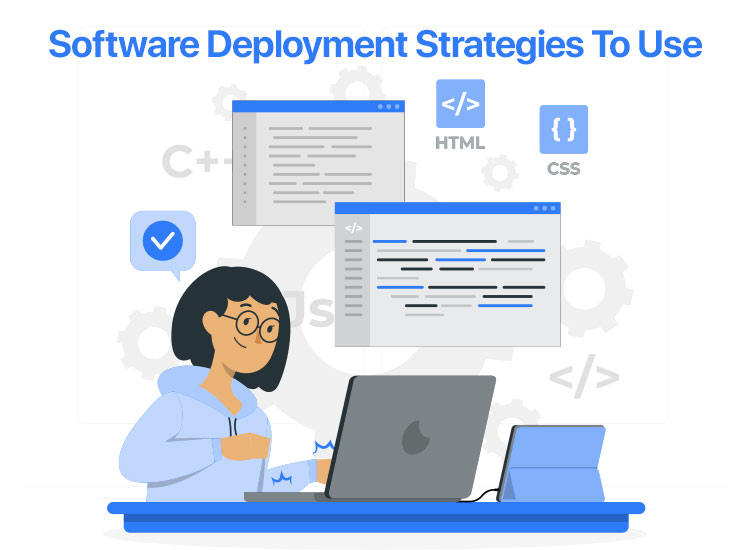
If you wish to deploy a new software, then this article lists and explains some of the best software deployment strategies that can allow you to safely and effectively deploy software.
Software deployment is a crucial phase in the process of software development. The importance spectrum of the deployment stage is quite broad. Software deployment plays a key role in the development process because it brings consistency and reduces the chances of errors and risks. Apart from this, deployment also helps the team of developers to roll back to the previous version of the software if any glitch or error appears in the present version.
Any software’s initial success is reflected by the soundness of the deployment strategy. For any software development process, multiple types of software deployment strategies are available. Different strategies bring different results and hence, an extensive analysis is quite necessary before choosing the most accurate strategy for your product.
This article lists and explains some of the best software deployment strategies available for any business. The purpose of sharing these strategies with you is to help you choose the perfect one for your requirements. Hence, we suggest that you go through all the prominent strategies provided below and choose smartly.
Top Software Deployment Strategies
The sections below will help you learn about multiple software deployment strategies. Use the descriptions provided for each strategy to learn about it and choose the one you find suitable for your software deployment needs.
1. A/B Testing Deployment
This is one of the most common software deployment strategies. A/B Testing Deployment allows you to test the new version of a software against the older one. Under this strategy, the old version of the software is kept intact while the new version is shared with a handful of people.
These people use the new software and judge its performance and user-friendliness against the older version. If any discrepancies or glitches are found, the same are fixed in due time. Whereas, if the results are well-endowed, the new version of the software is rolled out to the public.
2. Recreate Deployment
Here’s the next strategy that you can use. Recreate deployment is one of the most unique software deployment strategies, and it is quite the opposite of the A/B Testing deployment strategy. Within the Recreate Deployment strategy, the entire system of the old version of the software is shut down. This means that the users of the old version may face some downtime.
Thereafter, the new version is launched and the system is booted up, allowing the users to get their hands on the new version. This is a reliable strategy of deployment, but the only disadvantage is the downtime that users face.
Also know: Best Computer Imaging Software
3. Ramped Deployment & Rolling Deployment
Ramped Deployment & Rolling Deployment can be considered two of the best software deployment strategies that are quite similar to one another. Within the Ramped Deployment process, a small number of servers are updated with the new software, and this value is slowly increased over the period.
Whereas, within the rolling deployment strategy, the new server is first introduced, and then the old one is removed to offer better control over the deployment process. Both of these strategies ensure that there is no downtime for the software and offer users access to one version of the software at all times.
4. Shadow Deployment
Let’s talk about the next strategy in this list of best software deployment strategies. Shadow deployment is another strategy of deployment that removes the situation of downtime. Using this strategy, the new version of the software is rolled up alongside the existing version. Thereafter, the “fork” technique is used to roll up the new version in place of the older version.
This strategy is quite beneficial for rolling out the new version of software to the general public. However, this process can be a bit complicated as the developers have to keep a regular eye on the rollout to ensure that there are no discrepancies in the process.
5. Big Bang Deployment
The Big Bang Deployment is the last strategy on this list of the best software deployment strategies. As the name suggests, the Big Bang deployment strategy is an immense and one-time deployment strategy that allows you to roll out the latest version of the software in place of an existing one at once.
This strategy is different from other incremental strategies as it works on a one-time execution model. Moreover, the big bang deployment strategy is quite complicated as well because it requires extensive testing and development before the final deployment.
Also know: The Best Anti-Malware and Protection Software for Windows PC
Deployment Tools and Strategies: Explained
So, it’s time to sum up this guide on the best software deployment strategies of all time. As it must be clear from the above sections, there are two main categories of deployment strategies, one that uses an incremental approach for deployment and the other that uses a one-time deployment approach. Both approaches have individual benefits and limitations. You can mirror your deployment requirements against the deployment strategies to determine the most accurate one.
If you need expert help in selecting the perfect strategy from the pool of software deployment strategies, you can use the comments section to ask your queries. Our tech experts will get back to you with helpful responses.

